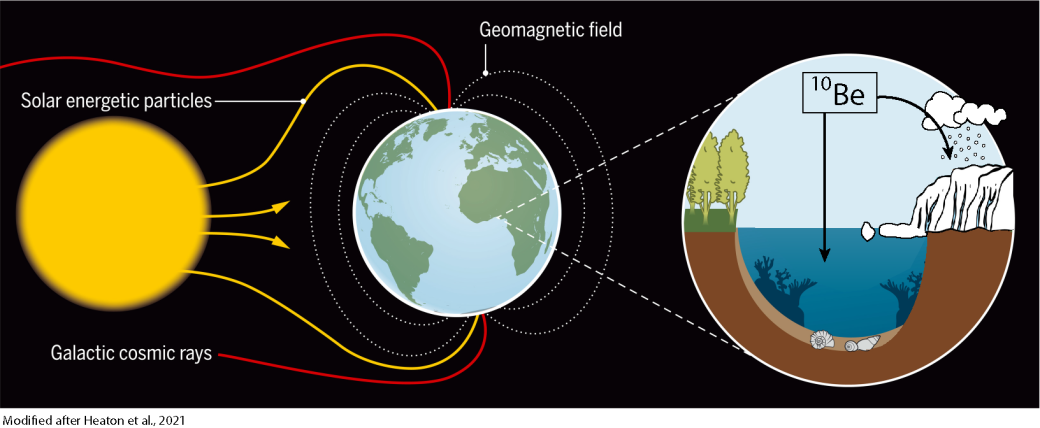
Lead supervisor: Francesco Muschitiello, Geography
Co-supervisor: Aidan Starr, Geography; Markus Czymzik, Leibniz-Institute for Baltic Sea Research
Brief summary:
Using a multidisciplinary approach, the student will develop and test a new geochronometer to establish precise timescales for paleoceanographic records. This will be achieved by reconstructing and synchronizing solar-modulated variations in cosmogenic 10Be from ice cores and marine sediments spanning the last 50,000 years.
Importance of the area of research concerned:
Greenland ice cores and North Atlantic seafloor records show clear evidence of concomitant rapid climate and deep-ocean circulation shifts during the last ~50,000 years. However, due to dating limitations associated with marine sediments, there remain significant uncertainties as to whether abrupt North Atlantic climate shifts led to or lagged behind changes in thermohaline circulation (Muschitiello et al., 2019). Cosmogenic radionuclides show great potential as a novel tool for establishing timescales of marine sediments and paleoceanographic reconstructions (Menabreaz et al., 2012). Recent research efforts have successfully quantified cosmogenic 10Be in marine sediment archives at high temporal resolution (Czymzik et al., 2020), opening up new exciting opportunities to utilize 10Be data for chronological applications in Paleoceanography. As the production rate of these cosmogenic nuclides is inversely related to variations in solar activity, the modulation integrated in 10Be is a truly external and globally synchronous signal, which makes it an ideal geochemical tool for continuous synchronizations of ice-core and marine records of past climate.
Project summary :
This project aims at generating the first multidecadal-resolved data sets of cosmogenic 10Be in a network of North Atlantic Ocean sediment cores to detect the globally common cosmogenic production signal associated with changes in solar activity. The new records will provide a means for precise and continuous synchronization to 10Be records from Greenlandic ice cores spanning the last ~50,000 years. Using new and published records of sea-ice cover, meltwater discharge, and deep-water circulation from the same sedimentary records, this novel synchronization approach will enable a detailed investigation of the relative phasing between abrupt climate shifts, freshwater forcing, and changes in the thermohaline circulation in the North Atlantic across several climate transitions.
What will the student do?:
The successful applicant will generate new high-resolution sediment records of cosmogenic 10Be to precisely synchronize the timescales of polar ice cores and North Atlantic marine records of the last ~50,000 years. The laboratory work will involve chemical 10Be and 9Be extraction from sediment samples using ICP-MS, and 10Be/9Be AMS measurements. To reduce environmental noise, the student will test the effects of potential secondary processes on marine 10Be, and where appropriate develop a correction method using flux-tracer normalization and reaction-transport modelling. This will help resolve the characteristic secular variations in solar activity associated with de Vries cycles (~200 years) preserved in marine sediments. The student will also conduct timeseries synchronization of the solar cycle modulations reconstructed in the marine and ice-core records, which will allow direct mapping of the marine stratigraphies onto the ice-core timescale. Finally, the student will compare synchronized reconstructions of freshwater discharge and deep-water circulation directly to ice-core records to resolve the relative phasing between shifts in North Atlantic circulation and global climate.
References - references should provide further reading about the project:
Muschitiello, F., D’Andrea, W.J., Schmittner, A., Heaton, T.J., Balascio, N.L., DeRoberts, N., Caffee, M.W., Woodruff, T.E., Welten, K.C., Skinner, L.C. and Simon, M.H., 2019. Deep-water circulation changes lead North Atlantic climate during deglaciation. Nature communications, 10(1), pp.1-10.
Czymzik, M., Nowaczyk, N.R., Dellwig, O., Wegwerth, A., Muscheler, R., Christl, M. and Arz, H.W., 2020. Lagged atmospheric circulation response in the Black Sea region to Greenland Interstadial 10. Proceedings of the National Academy of Sciences, 117(46), pp.28649-28654.
Ménabréaz, L., Bourlès, D.L. and Thouveny, N., 2012. Amplitude and timing of the Laschamp geomagnetic dipole low from the global atmospheric 10Be overproduction: Contribution of authigenic 10Be/9Be ratios in west equatorial Pacific sediments. Journal of Geophysical Research: Solid Earth, 117(B11).
Applying
You can find out about applying for this project on the Department of Geography page.